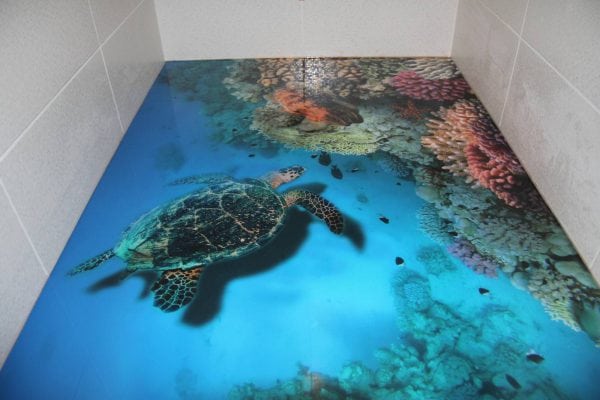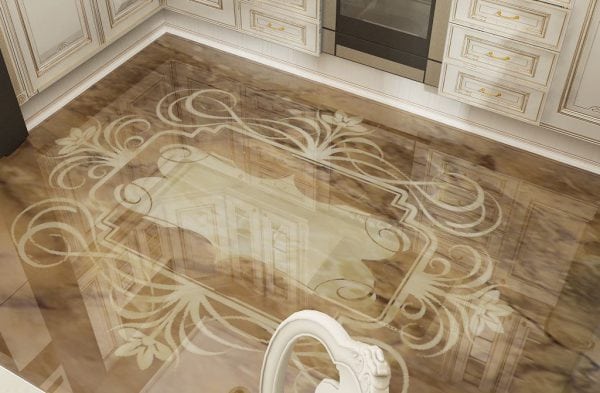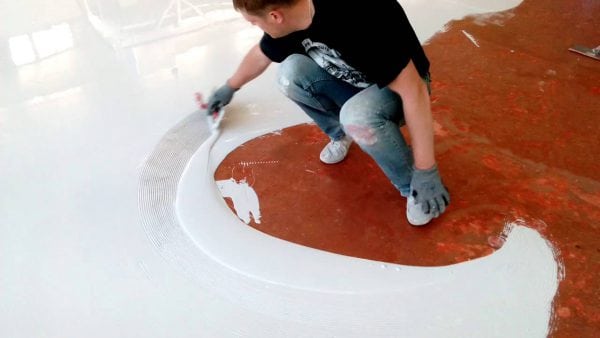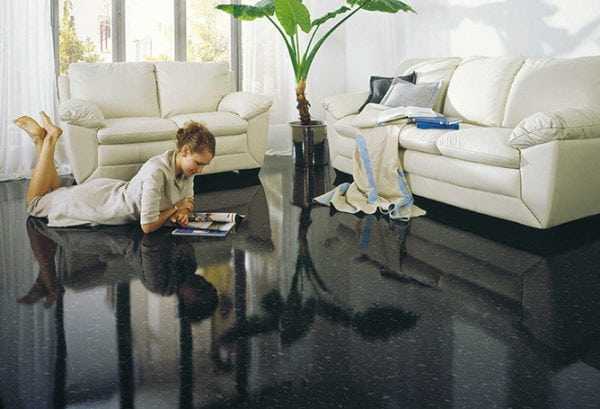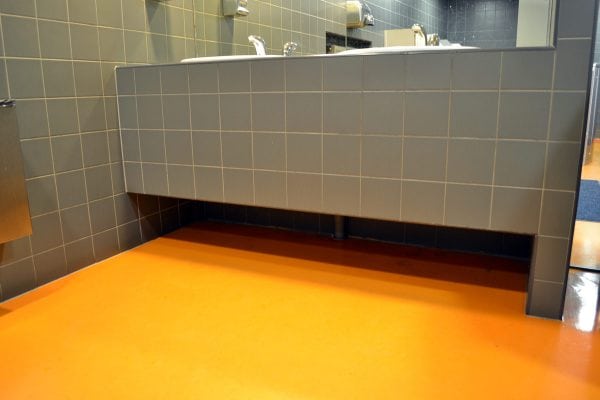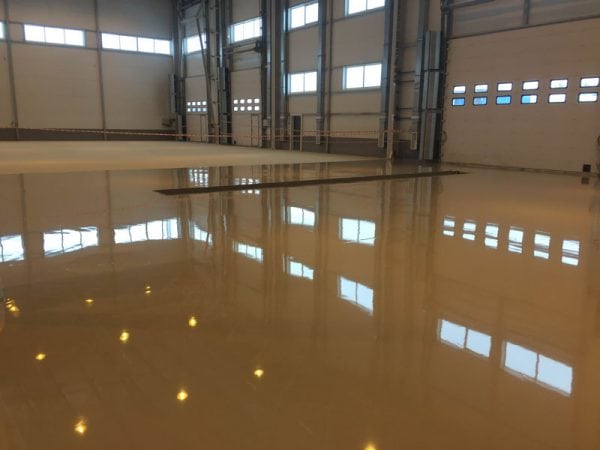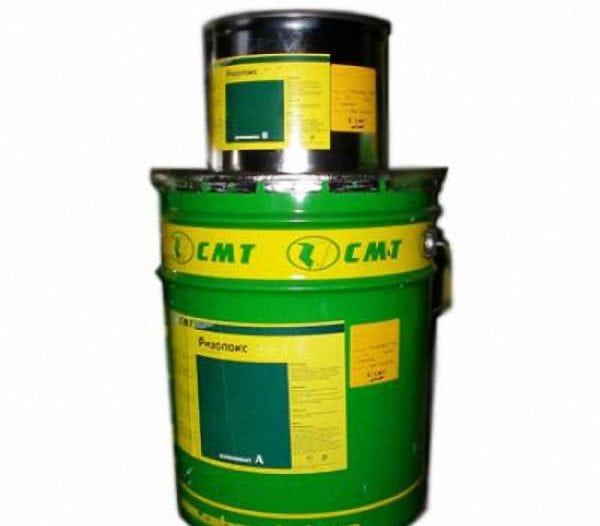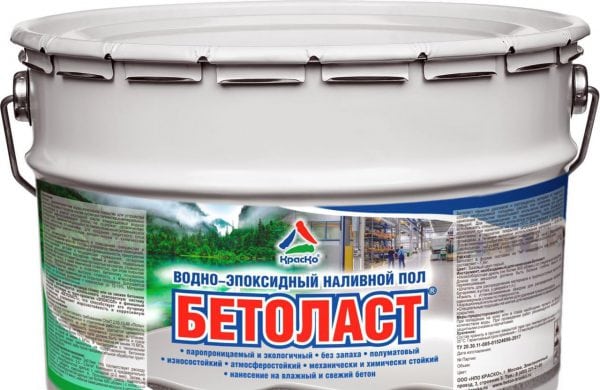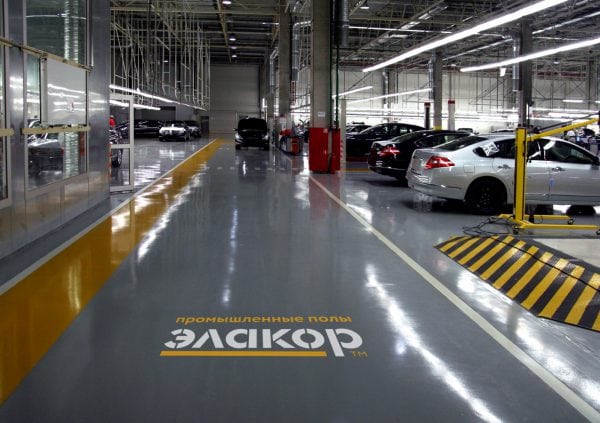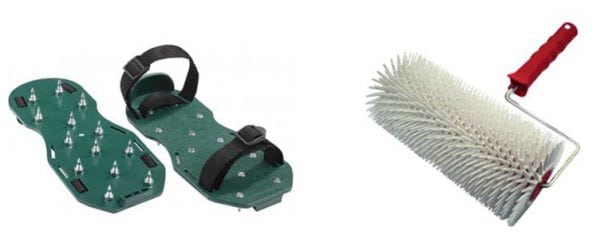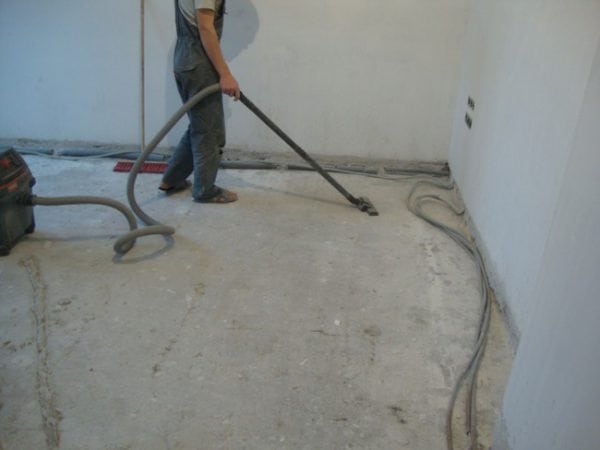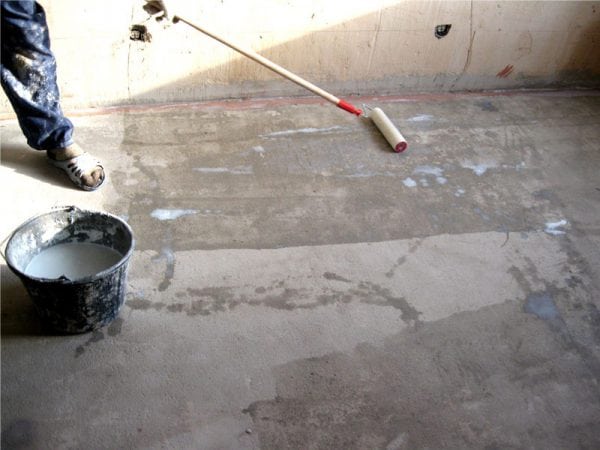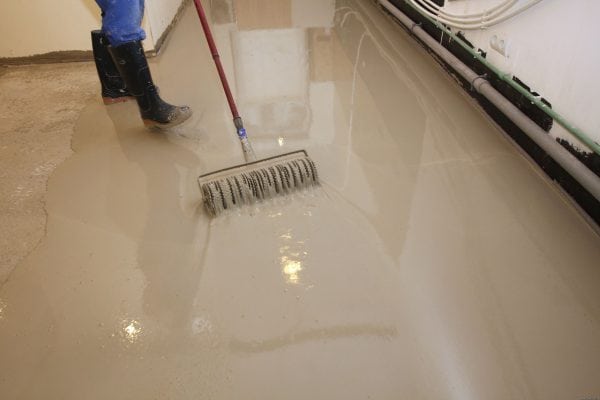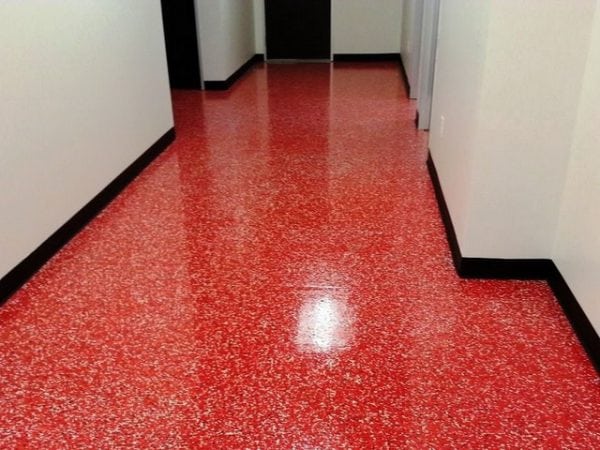Modern building technologies can significantly diversify the methods of arranging floors. For this purpose, the most unusual floor materials are used, including bulk ones. So, epoxy flooring is a unique coating that can be used in residential and industrial premises, in workshops, houses and apartments, in garages and catering establishments.
- Types, advantages and disadvantages of epoxy floors
- The relevance of arranging bulk epoxy floors
- In the apartment
- In the bathroom
- In the garage
- In night clubs and restaurants
- At industrial facilities
- Epoxy flooring - manufacturers and consumption
- Rizopoks
- Betolast
- Epolast
- Elacor ED
- Tools for work
- DIY flooring
- Surface preparation
- Primer and putty
- Base layer fill
- Topcoat
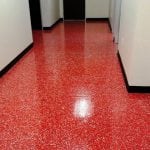
Types, advantages and disadvantages of epoxy floors
Epoxy resin for pouring, or compound - a liquid polymer containing epoxy groups and capable of hardening under the action of hardeners. Epoxy is used for the manufacture of varnishes and paints, glues, and other paints and varnishes. Bulk flooring is another possible area of application for the resin. It is perfectly combined with various additives, can be painted in many colors, has crystal transparency. This allows you to create original flooring, including - in 3D technology. For the installation of floors, fillers are necessarily introduced into the epoxy composition, giving strength, wear resistance, antistatic properties.
The production of bulk floors in recent years has seriously developed, so now companies offer many types of polymer epoxy coatings. They are made for specific operating conditions, which must be taken into account during installation. What are epoxy floors? Here are the main ones:
- thin-layer - form a layer of not more than 1 mm thick, have high resistance to chemicals and mechanical stress;
- thick-layer - each layer is not more than 1 mm, but their number is much larger, so the final coating is thick;
- quartz - quartz sand is added to the lower layer of the epoxy-based coating, which increases strength;
- industrial - such flooded floors withstand enormous loads of any nature.
The epoxy coating is colored, transparent or white, glossy or matte, perfectly smooth or rough. Some floors fulfill only the main purpose (providing a solid foundation), others additionally have decorative functions. Most epoxy mixtures are two-component, but there are one-component compounds.
The advantages of an epoxy floor are undeniable:
- high adhesion to any base - to concrete, wood or stone coating;
- excellent waterproofing of the floor surface;
- repulsion of dust, dirt due to antistatic properties;
- resistance to shock, UV radiation, abrasion, cracking;
- service life - up to 30-40 years;
- the possibility of purification by chemical means, the lack of reaction to the ingress of solvents, technical fluids;
- immunity to temperature extremes, ability to endure the whole winter in an unheated room;
- environmental friendliness, harmlessness to humans after complete curing;
- lack of fire hazard, incombustibility;
- perfect smoothness;
- aesthetic appearance, the ability to apply colors in any color spectrum.
Unlike polyurethane flooring, epoxy does not have a sharp unpleasant odor during installation. Such coatings create a large scope for the imagination of the designer, almost limitless. But the resin-flooded floors also have drawbacks. At a price they are far from cheap - you have to buy the actual epoxy resin, hardener, a number of tools and additional materials.
to contents ↑The complexity of preparatory and basic work is also much higher than when laying linoleum or laminate. It will not be easy to repair the surface - it is unrealistic to choose the color of the composition. Removing the coating is no less difficult than applying, it takes a lot of time.
The relevance of arranging bulk epoxy floors
Depending on the type of premises, a bulk floor with suitable properties and characteristics should be selected. So, in offices, garages and industrial premises the thickest and impact-resistant epoxy fillings are mounted. Thick-layer compounds are also required where there are significant differences in height, they can be applied to the tiles. Thin-layer compositions are used to fill the finish layer on the floor, and their consumption is minimal.
to contents ↑In the apartment
Often, craftsmen do the filling of the floors at home with their own hands. Advantages have already been clarified - it is strength, durability and reliability, as well as easy washing, beauty. But we must immediately take into account some of the disadvantages of bulk floors for apartments, residential premises. The fill compound is not too warm, and walking on it barefoot is unpleasant. If you combine the pouring with the installation of a warm floor, this drawback is leveled.
Another disadvantage is that changing a boring picture will be problematic. This is especially true of vivid photographs, collages, 3D-coatings glowing in the night darkness of phosphors. According to reviews, this decor quickly "palls" the residents. It is better to mount unobtrusive drawings, graphic images and other moderately bright options.
to contents ↑When installing an epoxy floor in an apartment, one must be prepared for high costs. If the floor is curved, with elevations and slopes, epoxy will be consumed in large volumes. For a beginner in working with epoxy, it is almost impossible to fill the compound, you will have to practice on less complex subjects.
In the bathroom
Usually the bathroom is covered with ceramic tiles, this solution is traditional. But some people prefer to flood the floor with epoxy, which is extremely waterproof. To wash such a floor is a pleasure, because it is slightly polluted and dusty. The lack of seams for the bathroom is another significant plus, since dirt will not clog in them. Even hot water and falling objects will not violate the aesthetics of the epoxy coating, although it seems fragile in appearance. Since the bathroom usually has a small area, the cost of repairs will be quite budgetary.
to contents ↑In the garage
Filling the floor of the garage box with epoxy is a great idea. The flooring in the garage is subjected to tough operation every day, it has to withstand the weight of the car, temperature fluctuations, and contact with chemistry. Therefore, "liquid linoleum," as the epoxy floor is also called, must meet high requirements. It is necessary to select special brands of mixes for pouring - especially durable, smooth to the touch, but not slippery. The floor service life is huge, it is easy to clean, and has good adhesion. An epoxy coating can be poured over the concrete floor, and a small area allows you to install yourself.
to contents ↑In night clubs and restaurants
In such rooms, a large number of people are constantly present, and the coating is subjected to high loads. Food is prepared in catering kitchens, there is high humidity and frequent temperature differences.In a nightclub, the aesthetics of the room and the original design appear in the list of additional requirements.
to contents ↑The decorative bulk floor from epoxy in the organizations of this type is very popular. The advantages are easy cleaning and fire-fighting properties of the coating, it does not burn, it does not allow the fire to spread. It is especially recommended to fill with epoxy compounds in such technological areas as kitchens, entrances, exits, unloading areas.
At industrial facilities
Floors in production halls and other industrial premises are the most wear part. The loads on them are very high and constant. These include walking people, vibration of equipment, the effect of low or high temperatures. In some places - high humidity, the influence of chemicals.
Industrial facilities use only special industrial epoxy floors. Their technical indicators are higher than conventional compounds for houses and apartments. Some polymer coatings easily withstand falling loads weighing several kilograms from a great height. Typically, these floors serve up to 20 years.
to contents ↑Epoxy flooring - manufacturers and consumption
On sale there are a number of tools for pouring epoxy floors in various rooms. The prices for them are not the same, imported mixtures are much more expensive. The spread of prices is 230-650 rubles per kilogram. The most famous brands are “Elacor ED”, “Betolast” and others.
Rizopoks
Rizopox 4101 is a self-leveling epoxy flooring. This two-component material does not include solvents, low-colored, equipped with a modified amine as a hardener. The tool allows you to get a floor with a smooth surface, perfectly flat. Such epoxy is widely used in industry, agriculture, sports facilities, on housing and public utilities facilities, and parking lots. The epoxy compound is especially popular for filling warehouses, garages.
"Rizopoks" can be used on a stone base, cast on concrete, cement-sand screed. The mass is resistant to damage, scratching, shock. Consumption as an epoxy primer is about 300-400 g / sq. m, to create the front layer of the floor covering - from 400-500 g and above.
to contents ↑Betolast
Water-epoxy bulk floor "Betolast" is odorless, includes special components and fillers to give a semi-matte shade. The tool is wear-resistant, weather-resistant, does not respond to chemicals, environmentally friendly, vapor-permeable. It is possible to apply epoxy material as a primer, including on fresh and wet concrete, on an old concrete base. The compound is suitable for garages and hangars, repair shops, basements, medical and child care facilities, apartments and houses. It is "breathing", does not violate the ecology of the room and the environment. When applied to wet concrete, pre-priming with Epoxol is required. When pouring low-grade concrete, they first impregnate with Aquastone deep penetration soil. Consumption with a layer thickness of 2 mm - up to 1 kg / sq. m
to contents ↑Epolast
"Epolast" is an epoxy compound for flooring with excellent decorative properties. The tool is two-component, solvent free. It is suitable for pouring concrete, natural stone, metal and wooden structures. "Epolast" is intended for rooms with high loads, can be subjected to constant moisture, abrasive cleaning. It creates chemical resistant epoxy floors, therefore it is widely used in workshops, garages, and parking lots. Consumption - up to 600 g / sq. m
to contents ↑Elacor ED
This color composition is highly durable, can be applied to the rough floor and as a topcoat.It does not have an unpleasant odor and is convenient to use. The product is not afraid of UV radiation. With a thickness of 1 mm, the consumption for litter is 300 g / sq. m, on the front cover - up to 1.5 kg.
to contents ↑Tools for work
Prior to the installation of the floor, it is advisable to familiarize yourself with the video on pouring compounds or read information in magazines for construction and repair (“Do it yourself” and others). Further, it is important to prepare the following materials and tools:
- synthetic winterizer roller for priming, needle roller - for removing air bubbles;
- rake for applying epoxy, putty knife - for leveling and grinding in hard to reach places;
- drill with a blade nozzle - will help in mixing the resin and hardener;
- paintbrushes - they can walk on the floor, they will not allow damage to the coating.
A solvent is also purchased for cleaning tools, and gloves, a respirator, and glasses are used for personal protection. You also need to have a vacuum cleaner to remove the remains of quartz sand in time, if it is used in the work.
to contents ↑DIY flooring
Dressing the floor can be done in many ways. It is easiest to pour special “chips” onto the base layer until it completely hardens. Also, after curing, the base is painted with acrylics. It is hand painting that will become the most original and unusual version of the decoration of the fill. Another way to give the floor decorative properties is to order a banner, a sticker in a printing house, on which any images are applied. Typically, stickers are made of vinyl. Modern 3D printing looks especially beautiful.
There are certain requirements that a room must meet:
- temperature + 5 ... + 25 degrees (the same indicator should be at the base on which the compound will be poured);
- composition temperature + 15 ... + 25 degrees;
- air humidity not more than 80%;
- humidity of the base is less than 4% (for the Betolast mixture - up to 12%).
Surface preparation
The most reliable base for epoxy is the concrete floor. But, if necessary, you can pour the mass on other bases, even on tiles. Only with wooden bases can problems arise, because over time they become deformed.
It is important that the flooring is dry, even enough. Permissible deviation from the horizontal is not more than 2 mm for every 2 meters. Self-leveling mixtures can cover the floor and with serious deviations from this norm. The humidity of the floor is determined as follows: a film of polyethylene 1 * 1 m in size is glued with tape to the floor, left for 48 hours. If there is not a lot of moisture under the film, the floor can be considered dry and ready for pouring. Fresh concrete screed is best left for 4 weeks, during which time its moisture content will return to normal.
All dirt, dust, grease, paint must be completely removed from any coating. Cracks should be repaired, as well as chips, other defects. You can also strengthen the base with a layer of epoxy paint. It is recommended to stick waterproofing along the walls. 2 hours before the start of work, the floor is vacuumed.
to contents ↑Primer and putty
The primer is kneaded in a separate container. Its components are interconnected, mixed at a speed of 500 rpm, first in the forward, then in the opposite direction. The result should be a homogeneous mixture. Next, let the primer stand for 3 minutes for the release of air bubbles. It is necessary to fully develop the soil in 40 minutes, then its properties are lost.
The primer is spread on the floor with a snake, distributed by a synthetic winterizer roller. Additional portions of the product are poured onto highly absorbent areas. Polymerization lasts a day. Then you can begin to putty chips, cracks, all the recesses. This is done with special putty mixed with quartz sand (1: 3). After hardening putty put another layer of primer.All subsequent stages begin in a day.
to contents ↑Base layer fill
This layer is intended for the final smoothing of all irregularities, mashing of pores. The layer thickness is about 1.5 mm. Kraskoobi are put on feet in advance, go into them very carefully. The composition is prepared as indicated in the instructions. It is poured on the floor at the rate of 300-400 g / sq. m. Distribute the composition on the basis, and after 20 minutes sprinkle quartz sand of fine fraction (about 1.5 kg per 1 sq. m).
to contents ↑20 hours after the final polymerization of the mass, the remaining sand is removed with a hard plastic brush, another layer is applied with approximately the same epoxy consumption. Distribute it with a rubber spatula or squeegee. Particularly carefully work out the corners, places near the walls. After 15 hours, you can apply decor.
Topcoat
The final stage requires special care in the work. Epoxy is prepared in a similar way, poured on the floor in wide stripes. Consumption - from 1 kg / sq. m. Distribute the composition of the squeegee, and after 15 minutes, roll with a needle roller. Leave the bulk floor to harden for a day, but the load on it is permissible only after 6 days. After this period, you can apply a layer of epoxy varnish, but this is an optional step.
The technology is very time-consuming, it is recommended to watch a thematic video:

